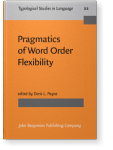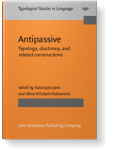Doris L. Payne
List of John Benjamins publications for which Doris L. Payne plays a role.
Book series
Journal
ISSN 0378-4177 | E-ISSN 1569-9978
Titles
Beyond Aspect: The expression of discourse functions in African languages
Edited by Doris L. Payne and Shahar Shirtz
[Typological Studies in Language, 109] 2015. vii, 321 pp.
Subjects Discourse studies | Semantics | Syntax | Theoretical linguistics | Typology
External Possession
Edited by Doris L. Payne and Immanuel Barshi
[Typological Studies in Language, 39] 1999. ix, 573 pp.
Subjects Historical linguistics | Syntax | Typology
Pragmatics of Word Order Flexibility
Edited by Doris L. Payne
[Typological Studies in Language, 22] 1992. viii, 320 pp.
Subjects Discourse studies | Pragmatics | Syntax | Theoretical linguistics | Typology
2021 Chapter 14. The profile and development of the Maa (Eastern Nilotic) antipassive Antipassive: Typology, diachrony, and related constructions, Janic, Katarzyna and Alena Witzlack-Makarevich (eds.), pp. 447–480 | Chapter
Maa (Eastern Nilotic) language varieties have nominative/accusative syntactic patterns, but also an antipassive construction marked by the verb suffix -ɪshɔ(r). This suffix turns an otherwise transitive construction into an intransitive one that can no longer express the P. Semantically the… read more
2021 Chapter 11. Polyfunctional vanka- in Nivaĉle and the antipassive category Antipassive: Typology, diachrony, and related constructions, Janic, Katarzyna and Alena Witzlack-Makarevich (eds.), pp. 349–382 | Chapter
Nivaĉle (Mataguayan) is a non-ergative language of Argentina and Paraguay. It has a voice/valency mechanism that resembles an antipassive. Stell (1989: 310) refers to vanka- as an intransitive marker. Fabre (2015, 2016) glosses vanka- as ‘antipassive’ but does not provide an in-depth analysis. We… read more
2020 Chapter 13. Robust argument phrases (DPs) but unruly NPs in Maa The ‘Noun Phrase’ across Languages: An emergent unit in interaction, Ono, Tsuyoshi and Sandra A. Thompson (eds.), pp. 329–362 | Chapter
Maa (sometimes referred to as Maasai) discourse and syntax largely require determined phrases. NP is not a robust construction in Maa, partly because ‘noun’ is not highly distinguished morphosyntactically from ‘adjective.’ Either can be a syntactic argument just if preceded by a determiner;… read more
2018 Chapter 10. Locative, existential and possessive predication in the Chaco: Nivaĉle (Mataguayan) and Pilagá (Guaykuruan) Nonverbal Predication in Amazonian Languages, Overall, Simon E., Rosa Vallejos and Spike Gildea (eds.), pp. 263–294 | Chapter
Nivaĉle (Mataguayan) and Pilagá (Guaykuruan) languages, which geographically overlap in the Argentinian Chaco region of South America, present evidence challenging the often repeated claim that locative predications universally underlie possession predications (Lyons 1967; Jackendoff 1983;… read more
2017 Chapter 9. Non-uniform syllable weight in Southern Kenyan Maa (Maasai) Syllable Weight in African Languages, Newman, Paul (ed.), pp. 143–160 | Chapter
2015 Aspect and thematic clause combining in Maa (Nilotic) Beyond Aspect: The expression of discourse functions in African languages, Payne, Doris L. and Shahar Shirtz (eds.), pp. 23–52 | Article
The Maa (Maasai, Eastern Nilotic) n[HL]- verb prefix has been called a “Narrative tense” or a “Narrative” morpheme. Rigorous discourse study shows that though it can occur on sequential semantically perfective main events, it is not limited to marking narrative events. Overall it marks high… read more
2015 Discourse structuring and typology: How strong is the link with aspect? Beyond Aspect: The expression of discourse functions in African languages, Payne, Doris L. and Shahar Shirtz (eds.), pp. 1–22 | Article
2013 The challenge of Maa ‘Away’ Functional-Historical Approaches to Explanation: In honor of Scott DeLancey, Thornes, Tim, Erik Andvik, Gwendolyn Hyslop and Joana Jansen (eds.), pp. 259–282 | Article
All branches of Eastern Nilotic have directionals. The Maa (Maasai) away morpheme has a range of functions, including motion away, direction away, distributive action or situation, continuous aspect, a possible plurality function, an applicative-like function, and with some verbs a valence… read more
2011 The Maa (Eastern Nilotic) Impersonal construction Impersonal Constructions: A cross-linguistic perspective, Malchukov, Andrej L. and Anna Siewierska (eds.), pp. 257–284 | Article
The Maa (Maasai) Impersonal construction occurs with intransitive, (di)transitive, active and stative verb stems. It implies either no agent or at most unspecified non-
referential “people” as a possible agent. Likely because of the possible implication of “people”, it has not been found with… read more
2008 Review of Fried & Boas (2005): Grammatical Constructions. Back to the Roots Studies in Language 32:1, pp. 211–218 | Review
2003 Review of Baron, Herslund & Sørensen (2001): Dimensions of possession Functions of Language 10:1, pp. 109–116 | Review
1999 What Counts as Explanation? A functionalist approach to word order Functionalism and Formalism in Linguistics: Volume I: General papers, Darnell, Michael, Edith A. Moravcsik, Michael Noonan, Frederick J. Newmeyer and Kathleen Wheatley (eds.), pp. 137–166 | Article
1999 External Possession: What, Where, How, and Why External Possession, Payne, Doris L. and Immanuel Barshi (eds.), pp. 3–32 | Article
1997 The Maasai External Possessor Construction Essays on Language Function and Language Type: Dedicated to T. Givón, Bybee, Joan L., John Haiman and Sandra A. Thompson (eds.), pp. 395–422 | Article
1995 Verb initial languages and information order Word Order in Discourse, Downing, Pamela A. and Michael Noonan (eds.), pp. 449–485 | Article
1994 The Tupí-Guaraní Inverse Voice: Form and Function, Fox, Barbara A. and Paul J. Hopper (eds.), pp. 313–340 | Article
1994 Active, inverse and passive in Maasai Voice and Inversion, Givón, T. (ed.), pp. 283–316 | Article
1992 Introduction Pragmatics of Word Order Flexibility, Payne, Doris L. (ed.), pp. 1–14 | Article
1992 Nonidentifiable information and pragmatic order rules in ‘O’odham Pragmatics of Word Order Flexibility, Payne, Doris L. (ed.), pp. 137–166 | Article
1986 Noun Classification in Yagua Noun Classes and Categorization: Proceedings of a symposium on categorization and noun classification, Eugene, Oregon, October 1983, Craig, Colette G. (ed.), pp. 113–132 | Article


















